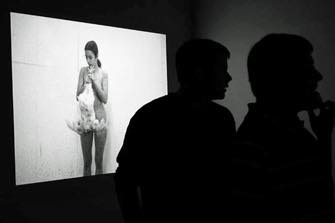
“What’s the point of going to see five hundred artworks by women?” a friend asked. “Would you go to see a show that advertised five hundred artworks by men?”
The question came up in relation to the Centre Pompidou’s new arrangement of its permanent collection: “elles@centrepompidou,” subtitled “Women Artists in the Collections of the Centre Pompidou.”
My friend’s question is a good one. All liberation movements need plenty of self-assertion and some affirmative action to make themselves heard early on in their struggle, but certainly the women’s movement has been around so long and made such strides that attention-getting devices and special privileges are no longer needed?
Maybe not. France, always behind in these matters (only in the past year has a black face been seen on French TV news, for example), certainly still seems to need a little affirmative action for women, but even in the United States, a land I thought was now a thoroughly liberated place for women, a new controversy has just arisen about the number of female artists represented (or not) in the Museum of Modern Art. “The Museum of Modern Art practices a form of gender-based apartheid,” wrote Jerry Saltz, art critic for New York Magazine, on his Facebook page a couple of weeks ago, engendering a lively debate. He noted that only 4 percent of the works currently on show in MoMA’s permanent collection are by women and that only nine of the 135 different artists represented are women. “MoMA is telling a story of modernism that only it believes,” he said. “MoMA has declared itself a hostile witness.”
Interestingly, Saltz’s argument is echoed in a 20-year-old piece by the Guerrilla Girls collective in the Pompidou show. In “Do Women Have to Be Naked to Get into U.S. Museums?” (1989), they used poster art to humorously attack the very same New York institution for exactly the same reason and with an almost identical figure: only 3 percent of the artists whose work was being shown at MoMA at the time were women, they note (while 83 percent of the nudes were female). Maybe a little affirmative action is in order after all.
According to the Pompidou Center, this is the first time ever that a museum has presented only works by women in its permanent collection. “The new hang is neither feminine nor feminist in its approach,” write the curators. “The idea is, first of all, to show and pay homage to these artists.” They have appropriately entitled one section of the show “A Room of One’s Own,” a reference to Virginia Woolf’s book of the same name explaining very clearly how the traditional role of women kept many of them from achieving greatness in the arts. This historic deprivation offers an apt justification for the affirmative action of this show.
So, what’s in this exhibition of five hundred works by women? A bit of everything, with works of varying levels of quality. There are installations by Annette Messager, Louise Bourgeois and Sophie Calle (all of whom have been the subjects of one-woman shows at Pompidou in the past few years); shock-value body art by the self-mutilating Orlan; a dress made of raw beef by Jana Sterbak; Niki de Saint-Phalle’s complex, monumental doll-like figure “Bride”; furniture by Charlotte Perriand and Gae Aulenti; gorgeous abstract paintings by Joan Mitchell and Helen Frankenthaler; one of Germaine Richier’s marvelous sculptures (others are on permanent display on the museum’s terrace); early 20th-century paintings of women (naked and clothed) by Suzanne Valadon; Dorothea Tanning’ spooky hotel-room installation; a Tatiana Trouvé installation full of connections to nowhere; Atsuko Tanaka’s “Electric Dress”; and much, much more.
A goodly share of the pieces on show, but by no means all, have feminist themes, and – as always in the realm of political art – the best get their message across with humor (see Ghazel’s funny videos of a woman completely covered in a black burqa sunbathing, moonwalking, ice skating, etc.). Others use pornography or even a bit of sadistic voyeurism – the other day, a rather large group of people stared in fascination for quite a long time at Sigalit Landau’s video of a naked woman hula-hooping on a beach with a hoop made of barbed wire, complete with close-ups of the wounds it created.
What can we learn from this show of work only by women? That their work is just as diverse as that of men, for better or worse. Maybe in the future we won’t need this type of segregation anymore. MoMA take heed.
Centre Pompidou: 19, rue Beaubourg, 75004 Paris. Tel.: 01 44 78 12 33. Open 11 a.m.-9 p.m. Closed Tuesday. Métro: Rambuteau. Admission: €10-€12. Through May 2010. www.centrepompidou.fr
Favorite